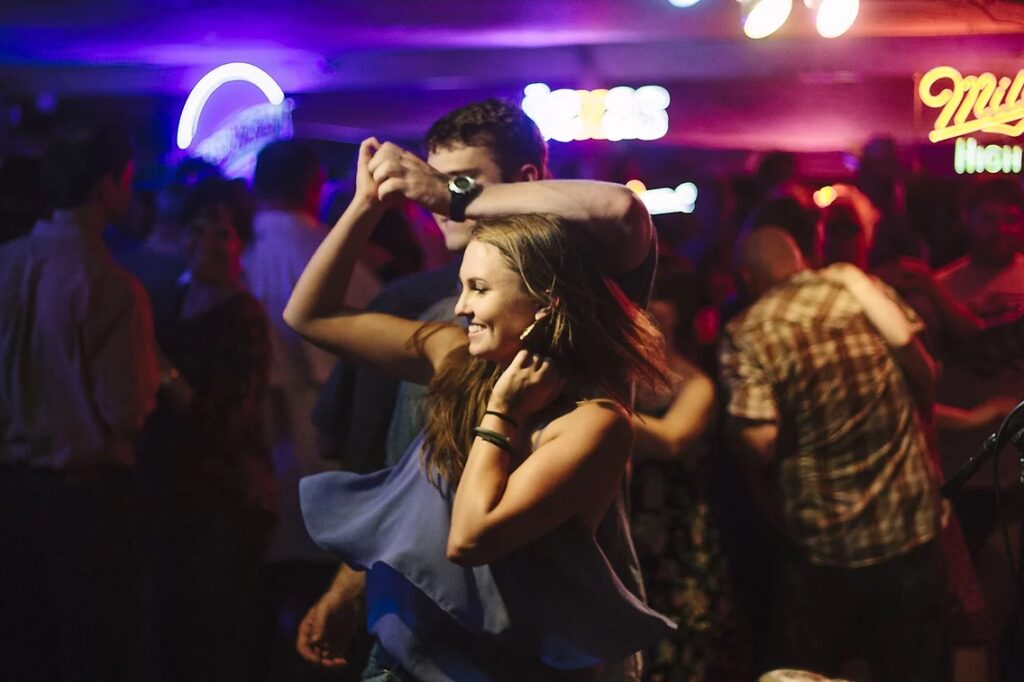On any given Saturday evening, dance halls across Texas come alive as folks gather to two-step the night away, boots shuffling across worn wood floors that emit nostalgic honky-tonk charm. Just what makes these dance halls a Lone Star tradition? “In one word, I would say community,” says Jake Dromgoole, interim director of Texas Dance Hall Preservation. “There are many dance halls around the state, and a lot of them were built as community gathering spaces that happened to have dances.”
The first Texas dance halls were built in the early 19th century by German, Czech, Polish, Tejano, and African American settlers. In 1836, after Texas won its independence from Mexico, immigrants continued to bring the latest steps with them and added new flavors to the Texas dance scene, including jigs, polkas, waltzes, and schottisches. While these halls have evolved from social gathering and multi-use community centers to primarily dance hubs, many still function, especially in rural areas, as a place for local events and celebrations—from barbecues to family reunions to graduation parties. Some operate as commercial businesses for the 21-and-up crowd, while others are owned by the community and run by volunteers who welcome all ages to their family friendly halls. All of them “have their own personalities and stories to tell,” says Deb Fleming, outreach coordinator for Texas Dance Hall Preservation.

At their peak, it is estimated that more than 1,000 dance halls existed in Texas, but many have been lost over time to highway construction, lack of consistent use, fires, weather-related incidents, or COVID. Since 2007, Texas Dance Hall Preservation has worked to save these historic places and the culture and music still found within their walls. “It’s rooted in our history as Texans just like the Alamo,” Deb says. The nonprofit provided $262,000 in COVID relief grants to 32 dance halls, which kept them afloat during pandemic shutdowns. “These places tell a story about the communities and the people who came to find a better life for themselves and struggled to make a life there. The culture of Texas is a patchwork of all these ethnic groups that came here and became the melting pot that is now Texas.”
While you can find dance halls all over the state, “Central Texas is where the majority of the dance hall action is at,” Deb says. Grab your boots and plan your next night out at one of these historic dance halls.
- Gruene Hall: Built in 1878, Gruene Hall is billed as Texas’ oldest dance hall and was built by first generation German immigrant Henry (Heinrich) D. Gruene in the German farming community of Gruene, now part of New Braunfels. Gruene (pronounced Green) has been recognized as a tourist destination and music venue for established and up-and-coming artists, as well as a proving ground for former new talents like George Strait, Hal Ketchum and Lyle Lovett.
- Twin Sisters Dance Hall: Twin Sisters was built by German immigrants in the 1880s and, outside of recent pandemic conditions, held a public dance on the first Saturday of every month ever since. This volunteer-run dance hall in Blanco serves as a community center for great music and dancing and in recent years has hosted gatherings like its annual Raise the Roof event in September and Fiddle Festival in early December.
- Broken Spoke: Any two-stepper near Austin has likely heard of this storied dance hall on South Lamar Boulevard that has welcomed music legends to its stage such as George Strait, Willie Nelson, and Dolly Parton. Good ol’ honky tonk music and a full bar keeps folks coming back week after week for many of the regular bands who rotate on the schedule Tuesday through Saturday night, and dance lessons are offered before most dances for those who need a refresher.
- Saengerrunde Hall: In 1852, German settlers in Austin formed a singing society that became known as Saengerrunde. Their favorite meeting place was Scholz Garden, a local restaurant and beer garden, dance hall, and bowling alley. Today, the venue serves as an event venue with annual festivals and holiday celebrations, including an Oktoberfest dinner and dance September 24.
- Anhalt Hall: With an enormous dance floor that can fit hundreds of two-steppers, Anhalt Hall was truly built for dancing and as some of the vintage signs will warn, no standing on the dance floor! All ages are welcome at the hall, and children 12 and under get in free. The next Anhalt dance is September 17 at 2390 Anhalt Road in Spring Branch, located on Highway 46 between Boerne and New Braunfels.
- Sisterdale Dance Hall & Opera House: In its early years, the Sisterdale Dance Hall & Opera House operated as an opera house and community center and later became a dance hall, community grocery store, and post office. The dance hall near Boerne was the center of musical life for the community, with tunes of all kinds flooding the hall, including classical opera, folk, rock, Tejano, Americana, and country music. The hall came under new ownership in 2009 and after being closed for a few decades was brought back to life shortly after, first with public dances on weekends and now as a full-time wedding and special event venue.
Visit the Texas dance hall map and plan your next Saturday night out.
